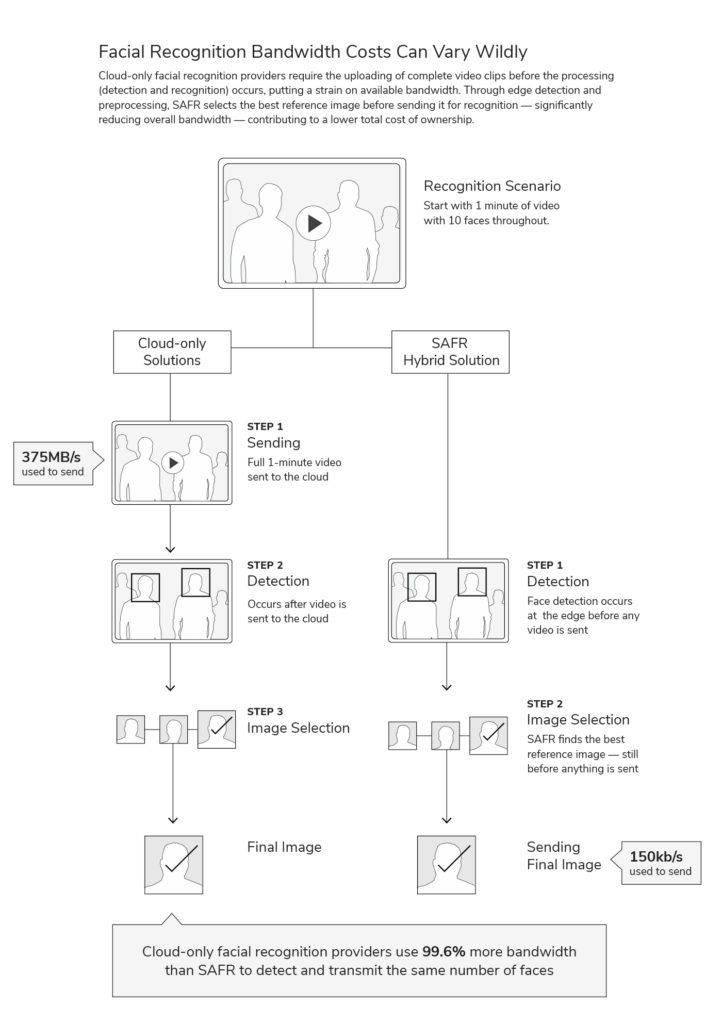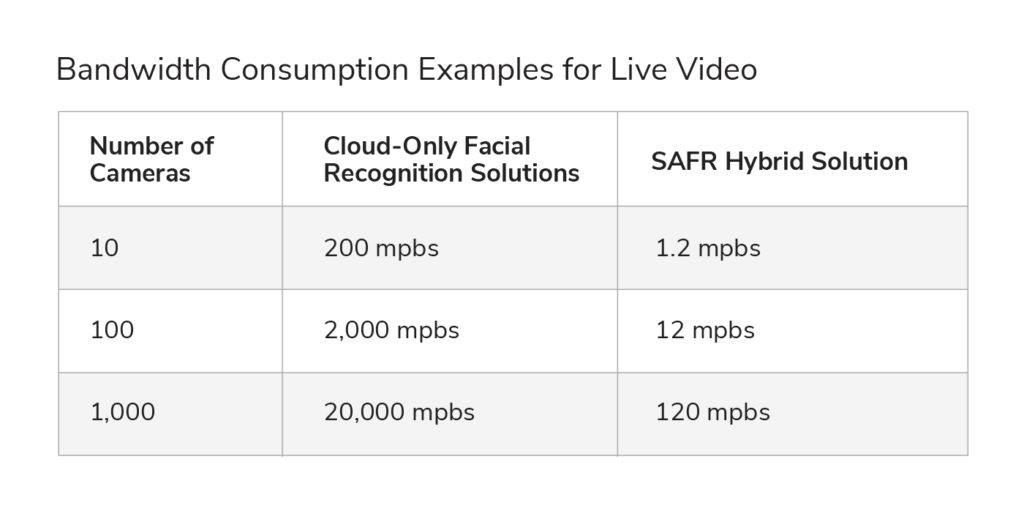Compared to cloud-only platforms, SAFR has a competitively lower total cost of ownership (TCO). Facial recognition industry Goliaths are no match for the strength of SAFR’s perfectly tuned algorithm — lightning-fast speed and high accuracy — and its edge processing advantage.
Extraordinary Bandwidth Savings at the Edge
SAFR’s hybrid solution divides the system into two parts, detection and recognition, utilizing the edge for face detection and processing, and the cloud or an on-premises server for recognition. This distributed architecture allows for efficient bandwidth consumption, reducing the roundtrip latency of recognition speed to under 100 milliseconds, even over 3G networks.
The largest cloud providers require the uploading or streaming of complete data-laden 4K video streams to the cloud before processing (detection and recognition) occurs. In contrast, SAFR handles the detection at the edge, in preprocessing, using local compute power to extract 15KB images of each face from the frame. Sending the extracted images rather than the full video stream saves a whopping 99.6 percent in bandwidth (see diagram below) over cloud-only providers.
It’s in this preprocessing stage that SAFR’s rapid speed allows it to quickly zero in on the best reference image before sending it for recognition, significantly reducing the number of recognition calls, lowering overall bandwidth, and also delivering a far more accurate match.

For those unfamiliar with the basic components of deploying facial recognition for live video, a quick primer: 1) an IP camera, 2) the facial recognition software, and 3) local hardware. The camera must be configured to a specific use case, and, unless it’s a fully embedded solution, the hardware must be connected to a network with the computational power to run the software. (These three components are fundamental to TCO, and since facial recognition costs can vary wildly, getting an accurate picture of everything TCO entails is challenging.)
Additionally, SAFR’s distributed architecture makes it highly scalable, whereas large deployments may prove cost-prohibitive for cloud-only solutions due to high bandwidth costs. Whether using 10 cameras or 1,000 cameras, SAFR is able to maintain bandwidth efficiency (see the chart below).

Competitive Pricing Further Reduces TCO
Compared to cloud-only providers, SAFR also includes a simpler, predictable pricing model. Instead of charging a per-minute fee, or a fee for every recognition event, SAFR simply processes a virtually unlimited number of recognitions, and customers pay a flat per-camera per-month subscription.
Consider a use case in which continuous monitoring is needed. A company choosing a cloud-only solution may deploy a camera to output JPEGs and upload them once per second, creating an excessive number of recognition requests. In a cloud-only solution in which the full frame is sent up for recognition, those per-image costs add up. Unlike cloud-only facial recognition solutions, SAFR offers world-class performance at predictable economics.
SAFR’s real-time, highly accurate, compact solution makes for a powerful TCO-besting combination. It’s designed to go the distance to become the fastest, most accurate, most cost-effective solution on the market.
—–
SDK Update: For developers and system architects looking to integrate facial recognition into their business, device or applications, SAFR offers frictionless access to its multi-platform SDKs. This includes support for both on-prem and on-device use cases, as well as limited or unavailable network connectivity. For more info about SAR’s dev offerings, contact us.
